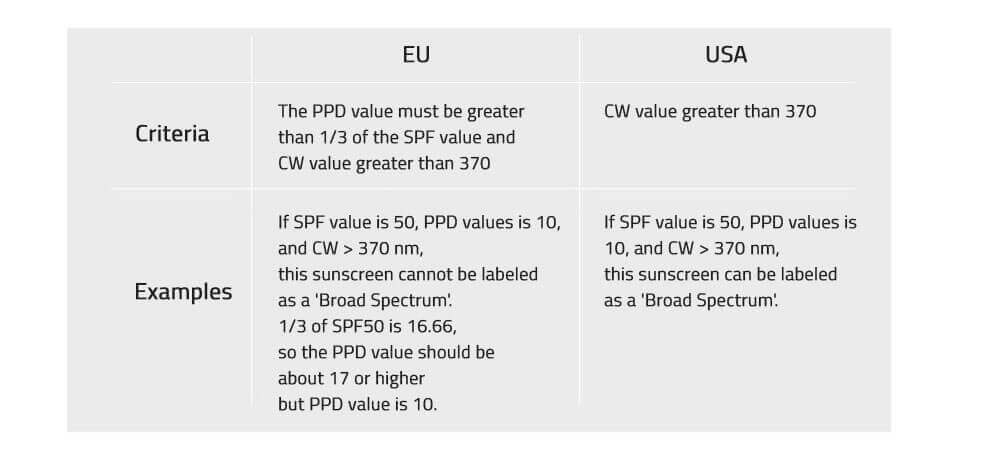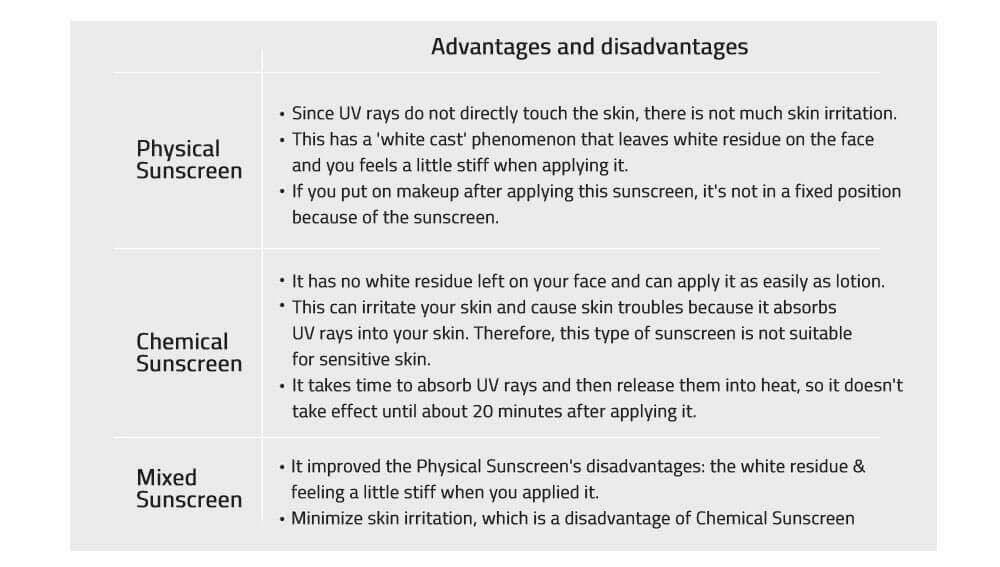SKIN CARE
Are you effectively blocking UV rays to prevent skin aging?
Anti aging, One of the topics that most people are interested in!
Sunscreen and Anti aging have a very close correlation that cannot be separated. Sunscreen to block UV is the most important part of our skincare routine.
As I mentioned in a previous article that 80% of facial aging is caused by UV rays, blocking UV rays in our daily lives is very important in anti aging.
Most people concerned about UV-related skin aging have used sunscreens to block UV rays in their daily lives as you who are reading this article. There are many kinds of sunscreens sold around us and their containers are marked with quite complex numbers or symbols. Therefore, we can effectively block UV rays only by choosing the right sunscreen for our application and applying it properly.
Now let’s understand the UV protection factor of the sunscreen and find out in detail how we can choose and apply it for proper anti aging.
Generally, sunscreens are produced and sold according to the following two criteria that block UV rays.
-
UV protection factor: SPF, PA
-
Critical Wavelength for Ultraviolet
1. SPF(Sun Protection Factor for UVB)
If Asians get sunlight on the beach without applying anything, their skin will turn red in about 15 to 20 minutes, which is considered SPF 1.
In other words, the amount of sunlight at the time when the skin first turns red as the skin is exposed to UVB is called MED(Minimal Erythema Dose), this is the amount of sunlight the skin received for about 15 to 20 minutes.
This means the minimum amount of UVB rays needed for erythema to appear.
The important thing here is that the SPF index refers to the time for how long a sunscreen can block UVB not mean intensity.
In other words, it is important to note that sunscreen SPF15 and SPF 30 products do not have a double difference in UV protection power, but a double difference in protection time.
In fact, the UV protection power of the SPF 15 product is 93% and that of the SPF 30 product is 97%, so there is no big difference in UV protection power itself.
- SPF 1 = The amount of sunlight that the skin can withstand for 15 minutes from UVB
- SPF 30 = 15 minutes * 30 =450 minutes (about seven and a half hours)
- SPF 50 = 15 minutes * 50 = 750 minutes (about 12 and a half hours)
If you use a sunscreen with SPF 50, it blocks UV rays for more than 12 hours, so it doesn’t make much sense to use a sunscreen with SPF 60 or higher in your daily life.
In the case of Korean sunscreen, the protection factor is marked as SPF 50 + for products over SPF 50.
2. PA(Protection factor of UVA)
In the case of SPF, the standards are similar around the world, so anyone can easily understand just by looking at the protection factor index.
However, in the case of PA that blocks UVA, the marking method of Korea and Japan is the same, and the standards and marking methods of the US and Europe are different.
Persistent Pigment Darkening (PPD) is a widely used in vivo method for the measurement of UVA protection factors.
PPD stands for “Persistent Pigment Darkening” and measures how protective a sunscreen is against a long-term tan caused by UVA.
Sunscreens produced in Korea measure the PPD from 2 to 100 and are given the PA index, which is the UVA protection factor.
Because it is difficult for ordinary consumers to recognize the blocking effect of UVA through PPD indexes, the greater the blocking effect on UVA, the more number of ‘+’ marks is added after PA letter, so that consumers can understand it more easily.
Most products are marked with only PA values, so consumers can not know the specific PPD value.
Some European products have PPD values written on containers.
3. Critical Wavelength(CW)
The Critical Wavelength is another measurement method for measuring the blocking effect of UV.
UV rays have a wavelength below.
- UVB: 280 nm to 320 nm
- UVA: 320 nm to 400 nm
CW means that the minimum reference point that can block 90% of all UV rays is set as a threshold of 370 nm. This means that the minimum reference critical wavelength that can block 90% of all UV rays is set at 370 nm.
In other words, products to which this measurement method is applied refer to products that can block all UV rays in the wavelength range of at least 280nm and 370nm, and a separate mark or text is displayed on the container of the product.

Mark on sunscreen container according to Critical Wavelength Measurement
UVA ULTRA
This is a European standard mark, and the UVA Ultra mark can be applied only to sunscreen products with SPF and PPD indexes of 3:1 or higher.
Mark the letters UVA in a circle like these.

Broad Spectrum
In the U.S. and Europe, sunscreen products with a CW of 370 nm or higher are labeled Broad Spectrum, but the labeling criteria are slightly different as shown in the table below.
Product examples marked with UVA ULTRA and Broad Spectrum.
I explained it complicatedly above, but to sum up, if you buy products marked below, you buy products with good UV protection.
4. Selection of sunscreen by ingredient and how to apply it.
Types of sunscreen according to ingredients
In order to increase the SPF index, various UV blocking ingredients must be combined, so these ingredients can be irritating to sensitive skin.
There are three types of sunscreen depending on how it is manufactured:
- Physical Sunscreen (Inorganic/Mineral Sunscreen): It literally refers to a sunscreen product that blocks UV rays by creating a thin protective film on the skin.
- Chemical Sunscreen (Organic Sunscreen): It refers to a sunscreen product that absorbs UV rays into the skin and then reacts organically to convert them into heat and then release them outside the body.
- Mixed Sunscreen: It refers to a sunscreen product made by combining the advantages of Physical Sunscreen and Chemical Sunscreen.
Advantages and disadvantages of each type of sunscreen
Do you know the right amount of sunscreen to apply to your face?
The SPF mentioned above refers to the measurement made after applying 2 milligrams of sunscreen per square centimeter.
To explain this in a simple way, it means that you need to apply a huge amount of sunscreen to your face to effectively block UV rays as shown in the image below.
No matter how anti aging it is, it is not easy for you to apply this amount of sunscreen to your face every day.
But few people in their daily life apply that much sunscreen to their face.
There are also experts who advise people to apply it frequently every two hours because they can’t apply that much sunscreens at once, but not many people also do so.
The amount of sunscreens we put on our faces in our daily lives is only about 25 % of the recommended amount.
This means that if we apply the SPF 50 sunscreen, it only works for about 3 hours.
750 minutes * 25% = 187.5 minutes = 3.125 hours.
If you apply the SPF 30 sunscreen, it means that it only has the effect of blocking UV rays for about an hour.
What kind of sunscreen should we choose and how should we apply it for anti aging?
Due to the problems mentioned above, it is recommended to apply twice the amount of sunscreen you are currently using for anti aging and you should choose SPF50+ products to extend UV protection time if possible.
BB cream and foundations also have UV blocking ingredients, but they contain so small amounts of ingredients that it is recommended to apply them after using sunscreen. It’s better to apply sunscreen in the morning if possible.
Chemical sunscreen recommends applying before moisturizing cream, Physical sunscreen recommends applying after moisturizing cream.
There are cream types and spray types of sunscreen, but if you use a spray-type sunscreen, it is difficult to spread it evenly on your skin, so using a cream type is much more effective. If you need to use a spray-type sunscreen, you should spray it on your skin and rub it so that the sunscreen solution is well absorbed into your skin.
The important points about sunscreen to block UV mentioned above for anti aging are briefly summarized as follows.
-
Choose a SPF50+ product to extend UV protection time if you can when buying sunscreen.
-
Buy a product with Ultra UVA or Broad Spectrum printed on its label when you purchase a sunscreen to extend UV protection time.
-
Better to apply cream-type sunscreen rather than spray type in the morning.
-
Double the amount of sunscreen to extend UV protection time.
-
Even if you have sensitive skin, it is better to apply sunscreen to block UV, in this case, apply a physical sunscreen, not chemical sunscreen.











